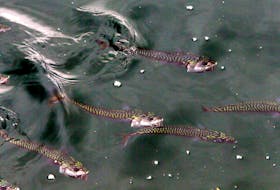Robert Way, a postdoctoral fellow in physical geography from Happy Valley-Goose Bay who studies permafrost and glaciology, said the ice thickness hasn’t been monitored like it was supposed to be.
“The problem is that Nalcor does not collect ice thicknesses through time downstream from Muskrat Falls,” he told the Labradorian. “It was something they committed to doing as part of the environmental assessment but they didn’t do it, or they haven’t been doing it.”
He said they monitor ice thickness at one place in the river, auguring six holes, which he says is a “really inadequate level of data collection.”
Way said the flood happened in two stages. First, there was a rise in river flow, that added about four feet to the river, and then there was an ice jam. Ice jams form at the mouth of the river on a semi-regular basis, he said, but there is usually minor, if any flooding.
“The first rise in river flow brought waters to what they usually are in the peak of the spring so it’s not that unusual in this case,” he said. “The second part, this flooding caused by the ice jam, brought it from the spring maximum to another five feet higher. This extra five feet of water obviously caused tremendous damage for Mud Lake.”
The independent assessment said in the preliminary report they presented to the people that the initial water flow was due to a rapid snowmelt upstream, which Way has no issue with.
The ice jam is where it gets murky. Way said normally they would go through the data to what ice thicknesses were throughout the winter, look at how flows varied throughout the winter and then try and see if some of the decisions made with the flow that were released from Muskrat Falls influenced how the ice was accumulating downstream.
He said it isn’t just that the data wasn’t provided, largely it doesn’t exist.
“That information has not been provided in that basis, it hasn’t been collected in that basis. It makes the job of the independent assessment a lot tougher, to be able to tease out what influences they may have had when that critical data is not being collected. “
Elsewhere in the country people use ice thickness to forecast flood potential, Way said, and very effectively. That data determines whether water should be released or not, as ice thickness is a large component.
Talking to the locals could have provided the independent assessment with more information on ice thickness, Way said.
“It was the thickest people in Mud Lake had ever seen it. People ice fishing in the area reported seeing it five feet thick.”
He said the independent assessment cannot attribute the event to Muskrat Falls but they don’t look at whether it could have been mitigated by a better monitoring program.
His position is that if Nalcor Energy had been collecting the type of data that it should have been collecting they would have been able to reduce the impact of the flood and been able to predict that it was likely to occur and correspondingly could have warned people.
“If Nalcor had considered there was really thick ice downstream they potentially could have held back some water or warned the community this was a possibility. They didn’t.”









